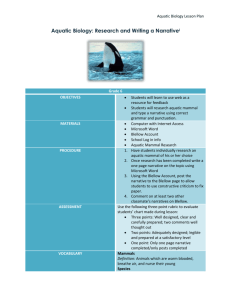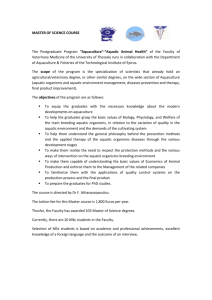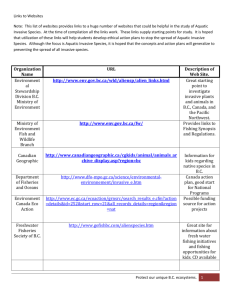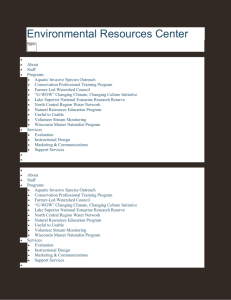“The Ecosystem Disrupters: A Middle School Look at Aquatic
advertisement
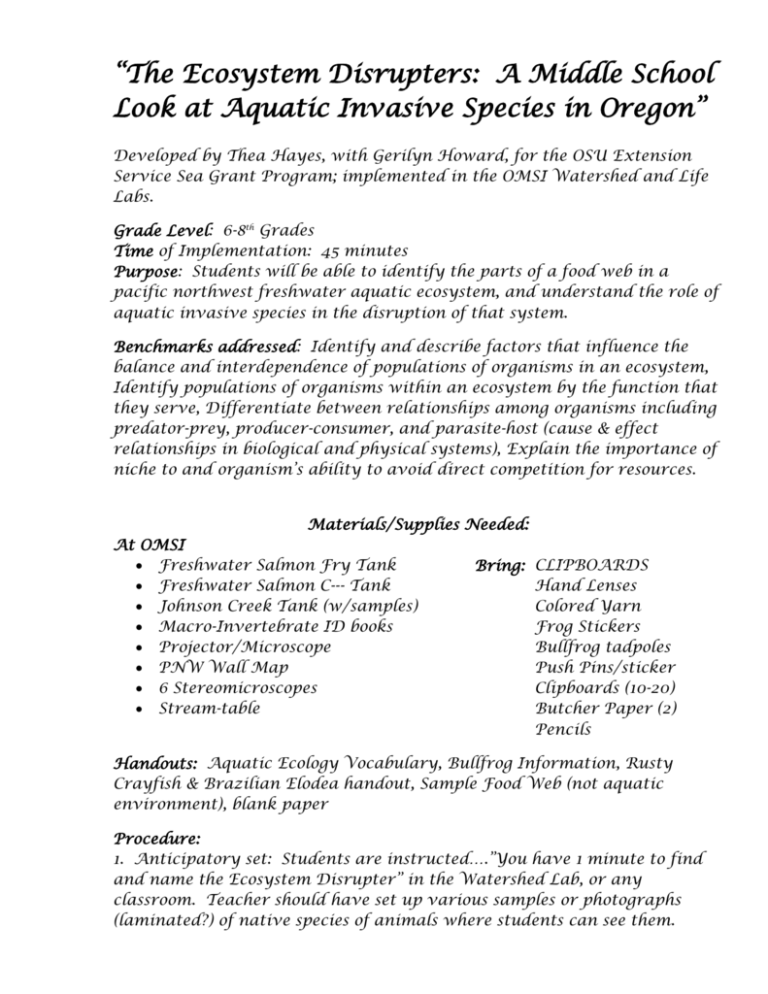
“The Ecosystem Disrupters: A Middle School Look at Aquatic Invasive Species in Oregon” Developed by Thea Hayes, with Gerilyn Howard, for the OSU Extension Service Sea Grant Program; implemented in the OMSI Watershed and Life Labs. Grade Level: 6-8th Grades Time of Implementation: 45 minutes Purpose: Students will be able to identify the parts of a food web in a pacific northwest freshwater aquatic ecosystem, and understand the role of aquatic invasive species in the disruption of that system. Benchmarks addressed: Identify and describe factors that influence the balance and interdependence of populations of organisms in an ecosystem, Identify populations of organisms within an ecosystem by the function that they serve, Differentiate between relationships among organisms including predator-prey, producer-consumer, and parasite-host (cause & effect relationships in biological and physical systems), Explain the importance of niche to and organism’s ability to avoid direct competition for resources. Materials/Supplies Needed: At OMSI Freshwater Salmon Fry Tank Freshwater Salmon C--- Tank Johnson Creek Tank (w/samples) Macro-Invertebrate ID books Projector/Microscope PNW Wall Map 6 Stereomicroscopes Stream-table Bring: CLIPBOARDS Hand Lenses Colored Yarn Frog Stickers Bullfrog tadpoles Push Pins/sticker Clipboards (10-20) Butcher Paper (2) Pencils Handouts: Aquatic Ecology Vocabulary, Bullfrog Information, Rusty Crayfish & Brazilian Elodea handout, Sample Food Web (not aquatic environment), blank paper Procedure: 1. Anticipatory set: Students are instructed….”You have 1 minute to find and name the Ecosystem Disrupter” in the Watershed Lab, or any classroom. Teacher should have set up various samples or photographs (laminated?) of native species of animals where students can see them. Students look at species of plants and animals under microscopes and in containers around Watershed lab, and follow teachers instructions. 2. Teacher holds up SIGN that reads “I’m a Big, Green Eating Machine….Who Am I?” (Answer: The ADULT version of the Bullfrog Tadpoles in the lab.) 3. Teacher makes groups of 3-4, and students are sent to observe Native and Invasive species in OMSI Life Lab. They sketch general and specific features of animals and plants. If activity is done in classroom, teacher has prepared stations with exhibits of different aquatic and aquatic-dependent species (plants and animals) to observe. An alternative to live exhibits might be informational stations with photographs and display text (bulleted, not in report form). 4. Students go back to Watershed Lab and receive Vocabulary Sheets. They fit organisms into a Wetland /Aquatic Food Web in their group by identifying what they eat, and what eats them. 5. Discuss in whole group the results of their small group. 6. Post larger BLANK food web on wall, and have students offer suggestions for filling in. 7. Discuss how invasives can take advantage of an aquatic environment. 8. Identify potential sites for disruption in the Food Web by Bull Frogs or Nutria or Invasive Aquatic Plants; put FROG STICKERS (or other) on spots where there is potential for ecosystem disruption. 9. Discuss what might be potential ways to STOP invasives from taking over a habitat, or to remove them once they are present. Extension Activity: Stream Table… Have selected students create an environment that shows how invasives can take advantage of an aquatic environment. Have them also show potential areas for reducing the threat of the invasives. Assessment: 1. Students will turn in their group food web with invasives included. Their design should include plants (producers), animals (primary and secondary consumers, omnivores), plankton (zoo & phyto), and decomposers or detritovores, with connecting strands between them. The drawing should also include pictures, descriptions, and notes. It should NOT include a food CHAIN or organisms that do not relate to aquatic environments. References & Resources: 1)Teacher Resources List: http://www.invasivespecies.org/resources/ 2)Teaching Students: http://www.sgnis.org/kids/index/html 3)Invasive Species Info. Node: Http://invasivespecies.nbii.gov 4)On the lookout for Aquatic Invaders: Identification Guide for the Pacific Northwest, by Scott Wiedemer and Samuel Chan, Oregon Sea Grant, Oregon State University, Corvallis, OR 2008 5)Food Webs: Interconnecting Food Chains, by Susan Gray, Compass Point Books, Minneapolis, MN 2008 6)Field Trips by Jim Arnosky, Harper Collins Publishers, NY 2002 7)“The Silent Invasion: Oregon Field Guide,” www.opb.org/programs/ofg/videos 8)www.statesmanjournal.com/apps/pbcs.dll/article?AID=20070922/VIDEO17/ 70922008 9)”Nab the Aquatic Invader,” http://www.sgnis.org/kids/ Useful Vocabulary for Students Ecosystems Habitat Niche Food Web Food Chain Invasive Species Riparian Aquatic Trophic level Herbivore Carnivore Omnivore Limiting Factor Decomposer Autotrophs Sun Algae Phytoplankton Zooplankton Heterotophs Detritus Producer 1st Level Consumer 2nd Level Consumer 3rd Level Consumer Predator Prey Adaptation Population Community Species



